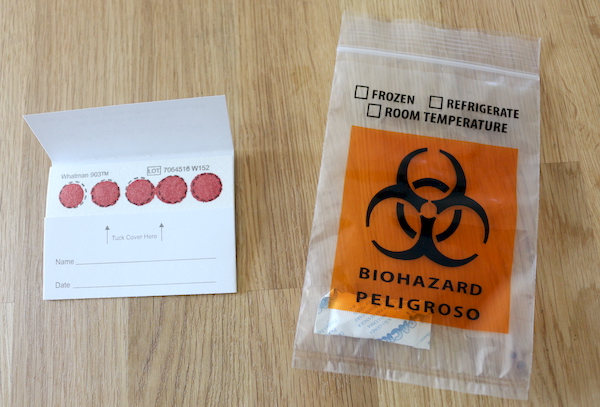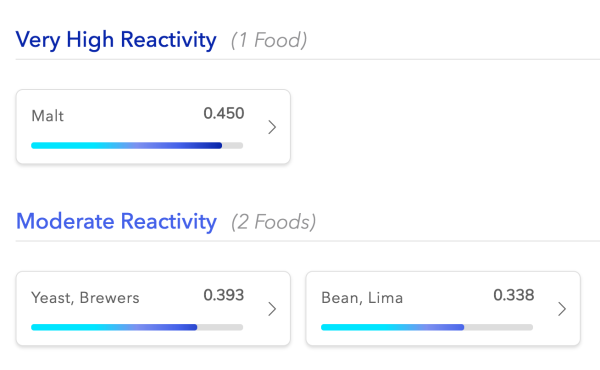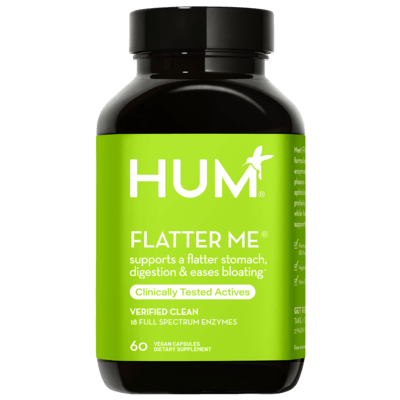We compare three different food-sensitivity tests and tell you which one to be wary of.
I like to think I eat pretty healthy about 80 percent of the time. My weekday diet consists of home-cooked veggies, lean proteins, and healthy fats. Still, you hear enough about food sensitivities and their all-too-familiar symptoms that make me wonder. Do unidentified blockages affect my digestion? Could eliminating a few pesky sensitive foods push my metabolism, energy, and focus into superdrive?
“About 70 to 80 percent of the immune system resides in the gut, so it makes sense that if you’re eating foods that promote inflammation, you’ll see effects across the body,” says registered dietitian Alex Caspero when I ask her thoughts on food-sensitivity testing.
With that endorsement, I reach out to the at-home health-testing gurus at EverlyWell. And just for good measure, I even compare the results to other popular food-allergy and sensitivity-testing methods.

 The results perplex me until I realize that malted grains produce beer and whiskey, aka my go-to drinks on weekend nights.
Caspero gives one caveat on IgG testing: “Elevated IgG levels don’t necessarily mean that the body’s having a negative response to a food; just that the body has been ‘exposed,’ whether this exposure is good, bad, or otherwise.”
Dr. Marra Francis, EverlyWell’s medical director, shares this article on the success of using IgG reactivity to guide elimination diets for improving health. “An antibody IgG immune response can offer guidance on what foods may be the best to eliminate. Rather than randomly eliminating foods over many months and assessing your change in symptoms, you can have a directed elimination plan.”
So, for now, it looks like I’ll be choosing vodka, gin, or tequila for any weekend imbibing. Cheers, EverlyWell! Thanks for the tip.
The results perplex me until I realize that malted grains produce beer and whiskey, aka my go-to drinks on weekend nights.
Caspero gives one caveat on IgG testing: “Elevated IgG levels don’t necessarily mean that the body’s having a negative response to a food; just that the body has been ‘exposed,’ whether this exposure is good, bad, or otherwise.”
Dr. Marra Francis, EverlyWell’s medical director, shares this article on the success of using IgG reactivity to guide elimination diets for improving health. “An antibody IgG immune response can offer guidance on what foods may be the best to eliminate. Rather than randomly eliminating foods over many months and assessing your change in symptoms, you can have a directed elimination plan.”
So, for now, it looks like I’ll be choosing vodka, gin, or tequila for any weekend imbibing. Cheers, EverlyWell! Thanks for the tip.
Food Sensitivity 101
First, it’s important to understand the difference between food allergies, intolerances, and sensitivities. A food allergy triggers an immune system reaction that can be quite severe or even life-threatening. With an allergy, IgE antibodies bind to mast cells and release histamine into body tissue. Symptoms include vomiting, diarrhea, hives, or even difficulty breathing. A food sensitivity, while still an immune system reaction, is less obvious than an allergy and will be delayed. Reactions occur in the blood instead of body tissue and are mediated by IgG and IgM antibodies. Symptoms may include headaches, fatigue, inflammation, skin problems, and digestive issues. By contrast, food intolerances occur in the digestive system rather than in the immune system. Intolerance symptoms include bloating, stomachaches, and an irritable bowel. They’re most often caused by a deficiency in digestive enzymes, as is the case with lactose or alcohol intolerances.Three Methods I Tested
1. Scratch Test
First, I visit Alan Khadavi, MD, in Beverly Hills. He specializes in allergy and asthma care to test for true food allergies. He uses the scratch test by administering small doses of allergens on my arms using a tiny prick. (It’s as painful as it sounds; it feels a bit like someone pressing a lego into your arm.) You then wait 15 minutes to see if any of the allergens cause an IgE reaction. I came out of this one in the clear, meaning I had no true allergies to any of the foods we tested. However, it doesn’t test for food intolerances or sensitivities.2. Applied Kinesiology
If you’ve ever seen an amazing food-sensitivity-testing deal on Groupon, be warned, as it might be this kind. In the test, you hold small vials of different allergens in one hand while your reflexes are tested in the other. If it sounds a little off the wall, that’s because it is. The theory is that if you have a sensitivity to the substance in question, your body’s reflexes are compromised. However, there’s no data to support this method. Still, ever curious, I give it a shot. My results claim that I have sensitivities to calcium, B-complex vitamins, fructose, lactose, vitamin A, grains, yeast, whiskey, beer, and coffee. I’m curious about eliminating some of these from my diet to see how I feel until the front desk tells me that for $75 a pop, they can heal these sensitivities one by one using a non-invasive massage technique. Something about it reminds me of psychics who sell you crystals to heal your past life, so I pass for now.
3. The EverlyWell Blood Test
In case you thought at-home testing is just for ancestry, meet EverlyWell. On the contrary, they offer a whole host of useful at-home health and wellness tests including ones for thyroid health, metabolism, vitamin-D deficiency, inflammation, heavy metals, cholesterol, and of course, food sensitivities. Their test uses a small blood sample to measure IgG reactions. The test comes with very clear instructions and everything you need to administer a sanitary prick to your finger to collect a blood sample. (If you’re squeamish, rest assured. I was nervous, but it was quick and less painful than a paper cut.) I mailed my sampling card back in the same box in which it was delivered and bam! They email me back results in less than a week’s time.The Surprising Results
When I log in to view my test results, I immediately see that I have low reactivity for 70 foods, mild reactivity for 23 foods, moderate reactivity to two foods and one food with a very high reactivity. The culprit? Malt! The results perplex me until I realize that malted grains produce beer and whiskey, aka my go-to drinks on weekend nights.
Caspero gives one caveat on IgG testing: “Elevated IgG levels don’t necessarily mean that the body’s having a negative response to a food; just that the body has been ‘exposed,’ whether this exposure is good, bad, or otherwise.”
Dr. Marra Francis, EverlyWell’s medical director, shares this article on the success of using IgG reactivity to guide elimination diets for improving health. “An antibody IgG immune response can offer guidance on what foods may be the best to eliminate. Rather than randomly eliminating foods over many months and assessing your change in symptoms, you can have a directed elimination plan.”
So, for now, it looks like I’ll be choosing vodka, gin, or tequila for any weekend imbibing. Cheers, EverlyWell! Thanks for the tip.
The results perplex me until I realize that malted grains produce beer and whiskey, aka my go-to drinks on weekend nights.
Caspero gives one caveat on IgG testing: “Elevated IgG levels don’t necessarily mean that the body’s having a negative response to a food; just that the body has been ‘exposed,’ whether this exposure is good, bad, or otherwise.”
Dr. Marra Francis, EverlyWell’s medical director, shares this article on the success of using IgG reactivity to guide elimination diets for improving health. “An antibody IgG immune response can offer guidance on what foods may be the best to eliminate. Rather than randomly eliminating foods over many months and assessing your change in symptoms, you can have a directed elimination plan.”
So, for now, it looks like I’ll be choosing vodka, gin, or tequila for any weekend imbibing. Cheers, EverlyWell! Thanks for the tip.
More like this









